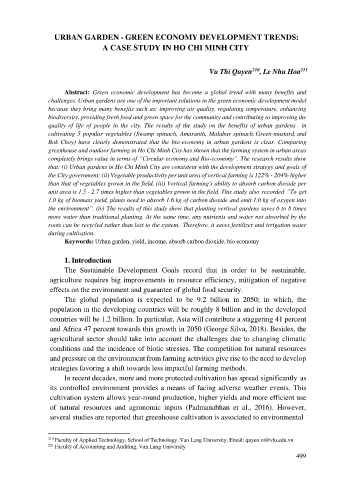Page 507 - Ebook HTKH 2024
P. 507
URBAN GARDEN - GREEN ECONOMY DEVELOPMENT TRENDS:
A CASE STUDY IN HO CHI MINH CITY
Vu Thi Quyen , Le Nhu Hoa
210
211
Abstract: Green economic development has become a global trend with many benefits and
challenges. Urban gardens are one of the important solutions in the green economic development model
because they bring many benefits such as: improving air quality, regulating temperature, enhancing
biodiversity, providing fresh food and green space for the community and contributing to improving the
quality of life of people in the city. The results of the study on the benefits of urban gardens in
cultivating 5 popular vegetables (Swamp spinach, Amaranth, Malabar spinach, Green-mustard, and
Bok Choy) have clearly demonstrated that the bio-economy in urban gardens is clear. Comparing
greenhouse and outdoor farming in Ho Chi Minh City has shown that the farming system in urban areas
completely brings value in terms of “Circular economy and Bio-economy”. The research results show
that: (i) Urban gardens in Ho Chi Minh City are consistent with the development strategy and goals of
the City government; (ii) Vegetable productivity per unit area of vertical farming is 122% - 204% higher
than that of vegetables grown in the field. (iii) Vertical farming's ability to absorb carbon dioxide per
unit area is 1.5 - 2.7 times higher than vegetables grown in the field. This study also recorded “To get
1.0 kg of biomass yield, plants need to absorb 1.6 kg of carbon dioxide and emit 1.0 kg of oxygen into
the environment”. (iv) The results of this study show that planting vertical gardens saves 6 to 8 times
more water than traditional planting. At the same time, any nutrients and water not absorbed by the
roots can be recycled rather than lost to the system. Therefore, it saves fertilizer and irrigation water
during cultivation.
Keywords: Urban garden, yield, income, absorb carbon dioxide, bio economy
1. Introduction
The Sustainable Development Goals record that in order to be sustainable,
agriculture requires big improvements in resource efficiency, mitigation of negative
effects on the environment and guarantee of global food security.
The global population is expected to be 9.2 billion in 2050; in which, the
population in the developing countries will be roughly 8 billion and in the developed
countries will be 1.2 billion. In particular, Asia will contribute a staggering 41 percent
and Africa 47 percent towards this growth in 2050 (George Silva, 2018). Besides, the
agricultural sector should take into account the challenges due to changing climatic
conditions and the incidence of biotic stresses. The competition for natural resources
and pressure on the environment from farming activities give rise to the need to develop
strategies favoring a shift towards less impactful farming methods.
In recent decades, more and more protected cultivation has spread significantly as
its controlled environment provides a means of facing adverse weather events. This
cultivation system allows year-round production, higher yields and more efficient use
of natural resources and agronomic inputs (Padmanabhan et al., 2016). However,
several studies are reported that greenhouse cultivation is associated to environmental
210 Faculty of Applied Technology, School of Technology, Van Lang University, Email: quyen.vt@vlu.edu.vn
211 Faculty of Accounting and Auditing, Van Lang University
499

